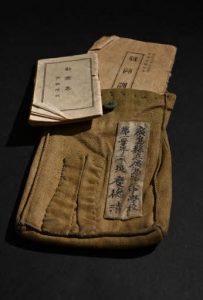Silent Witness: Military code, collection of imperial instructions
Jun. 21, 2021
Those killed in A-bombing included 13-year-old boy with bag of printed materials hanging from waist
by Kyoko Niiyama, Staff Writer
The aged booklets had been kept in a small cloth bag, measuring 16 centimeters in length and 11 centimeters in width. The printed materials comprised the military code of January 1941 known for the passage “Never disgrace yourself by being captured alive,” and a collection of imperial instructions that included the official military ethics code titled “Imperial Rescript to Soldiers and Sailors.”
Kiyoshi Keitoku, then 13 and a first-year student at Hiroshima Second Prefectural Junior High School (present-day Kanon High School), carried the bag with him. On August 6, 1945, he was mobilized to help tear down buildings to create fire lanes in the city with his classmates in the area of Nakajima-shinmachi (in Hiroshima’s present-day Nakajima-cho), where he was exposed to the atomic bomb’s thermal rays and blast at a distance of about 600 meters from the hypocenter.
The following day, his mother, Sadame, left their home in the Fuchu-cho area to desperately search for her son in the central part of Hiroshima but was unable to locate him. On the evening of the same day, after his mother had returned home in despair, Kiyoshi was returned home in a truck by five or six of his classmates.
His body was pinkish-brown all over, reminiscent of a grilled, dried squid. He had also been blinded in the bombing. As his consciousness faded, he called out his brother Susumu’s name and shouted, “Ote!” (in English, ‘Checkmate!’). Was he remembering the days when the two of them would together play shogi (Japanese chess)? He died at 8:15 a.m. two days later, on August 8.
Subsequently, 42 years later, Sadame wrote a passage in her journal that read, “There is nothing more painful than losing a child. That was the seed of my lifelong sorrow.”
(Originally published on June 21, 2021)








